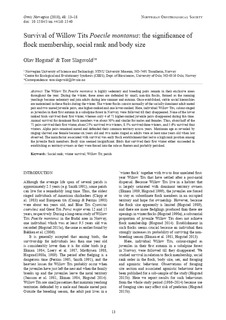| dc.contributor.author | Hogstad, Olav | |
| dc.contributor.author | Slagsvold, Tore | |
| dc.date.accessioned | 2019-04-10T06:01:23Z | |
| dc.date.available | 2019-04-10T06:01:23Z | |
| dc.date.created | 2018-10-30T20:08:08Z | |
| dc.date.issued | 2018 | |
| dc.identifier.citation | Ornis Norvegica. 2018, 41 13-18. | nb_NO |
| dc.identifier.issn | 1892-9737 | |
| dc.identifier.uri | http://hdl.handle.net/11250/2593914 | |
| dc.description.abstract | The Willow Tit Poecile montanus is highly sedentary and breeding pairs remain in their exclusive areas throughout the year. During the winter, these areas are defended by small, non-kin flocks, formed as the roaming yearlings become sedentary and join adults during late summer and autumn. Once established, stable social hierarchies are maintained in these flocks during the winter. The winter flocks consist normally of the socially dominant adult mated pair and two mated juvenile pairs, one higher-ranked and one lower-ranked. Individually colour-ringed juvenile Willow Tits were followed over years in subalpine forest in Norway from ringing in the autumn till they disappeared. None of the lower ranked birds survived their first winter, whereas only 4 of 71 higher-ranked juvenile pairs disappeared during this time. Half of the 71 pairs survived their first winter, about 25 % survived two winters, 8.5% survived three winters, and 5.6% survived four winters. Survival was similar for males and females. Alpha pairs remained mated and defended their common territory across years. Maximum age as revealed by ringing showed one female became six years old and two males ringed as adults were at least nine years old when last observed. The main factor associated with survival was early flock establishment that led to a high rank position among the juvenile flock members. Body size seemed insignificant. Birds that survived their first winter either succeeded to establish as territory owners or they were forced into the role as floaters and probably perished. | nb_NO |
| dc.language.iso | eng | nb_NO |
| dc.publisher | Norsk ornitologisk forening | nb_NO |
| dc.rights | Navngivelse-Ikkekommersiell 4.0 Internasjonal | * |
| dc.rights.uri | http://creativecommons.org/licenses/by-nc/4.0/deed.no | * |
| dc.title | Survival of Willow tits Poecile montanus: the significance of flock membership, social rank and body size | nb_NO |
| dc.type | Journal article | nb_NO |
| dc.type | Peer reviewed | nb_NO |
| dc.description.version | publishedVersion | nb_NO |
| dc.source.pagenumber | 13-18 | nb_NO |
| dc.source.volume | 41 | nb_NO |
| dc.source.journal | Ornis Norvegica | nb_NO |
| dc.identifier.doi | 10.15845/on.v41i0.1540 | |
| dc.identifier.cristin | 1625161 | |
| dc.description.localcode | Tidsskriftet er åpent for alle (Open Access), det vil si fri og gratis tilgang til alt publisert innhold. Lesere av tidsskriftet kan ta utskrift av de fremførte manuskriptene under samme betingelser som gjelder ved kopiering av fysiske eksemplar. Dette innebærer at masseframstilling av fysiske eksemplar, eller framstilling av eksemplar for kommersielle formål, ikke er tillatt uten etter avtale med forfatteren(e). | nb_NO |
| cristin.unitcode | 194,31,10,0 | |
| cristin.unitname | Institutt for naturhistorie | |
| cristin.ispublished | true | |
| cristin.fulltext | original | |
| cristin.qualitycode | 1 | |

